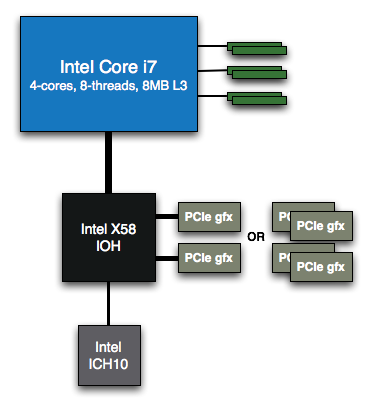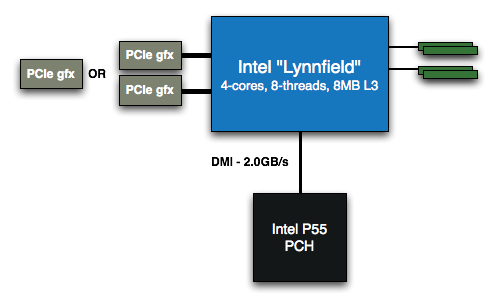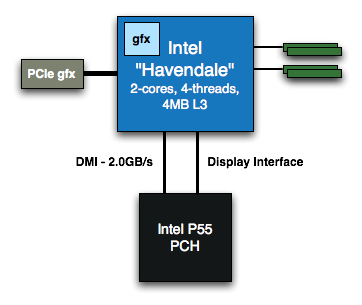Nehalem Part 3: The Cache Debate, LGA-1156 and the 32nm Future
by Anand Lal Shimpi on November 19, 2008 8:00 PM EST- Posted in
- CPUs
Mainstream Nehalem: On-chip GPU and On-chip PCIe
Let’s take a look at the Core i7, the first Nehalem incarnation:

Three DDR3 memory channels, a QPI link to the X58 chipset and support for multiple GPUs off of the X58 IOH. The Core i7, as you know by now, plugs into Intel’s new LGA-1366 socket. But in the second half of next year, there will be a new socket for mainstream users: LGA-1156.
Meet Lynnfield, it’s also a 4-core/8-thread design with an 8MB L3 cache, just like the Core i7, but it plugs into LGA-1156. Instead of 3-DDR3 channels it’s got two and instead of QPI it’s got Intel’s DMI connecting it to the chipset. It’s a lower bandwidth interconnect but Lynnfield doesn’t need a ton of bandwidth between it and the chipset, the reason being its secret weapon: Lynnfield has an on-package PCIe controller.

There are 16 PCIe lanes on Lynnfield (presumably PCIe 2.0) and they can be used as two x8s or a single x16, so you’ll get 2-way SLI/CrossFire support assuming all licensing silliness is worked out. The close proximity of the PCIe controller to the CPU could mean some very interesting things for latency, if well designed Lynnfield could have the lowest latency CPU-GPU connection we’ve seen on a desktop PC. Whether or not that’ll actually mean anything for real world performance remains to be seen, I’d guess not but it’s neat to talk about nonetheless.
Next up we’ve got Havendale, this is a 2-core/4-thread part with a 4MB L3 (still 2MB of L3 per core, just like Lynnfield and the Core i7). The “pinout” (if we can still call it that on these pinless CPUs) is the same as Lynnfield, so we’ve got a two channel DDR3 memory controller and DMI to the chipset.

Havendale’s secret sauce is that it’s got an on-package GPU, I’d expect it to be a bigger, better, faster variant of G45 (hopefully a lot better/faster) built on a 45nm process. This should beat AMD to the punch with the first single-chip CPU/GPU for mainstream desktops/notebooks, as AMD delayed its first APUs until 2011. Alongside the on-package GPU we've also got the same PCIe controller from Lynnfield.
The actual display output on Havendale will be through the chipset itself but the GPU and PCIe interface are on the CPU’s package. Harvendale only offers a single x16 PCIe slot, you can’t run it in 2 x8 mode.
At the right clock speeds, Havendale should be perfect for notebooks and desktops as well. These days two-cores with Hyper Threading would be the perfect mixture of cores/performance for the majority of consumers. As I noted in part 2 of our Nehalem coverage, give me Nehalem’s power efficiency in a notebook and I’ll be beyond happy.
The hiccup however is that we won’t see Havendale until Q1 2010. It’ll start production in Q4’09 but systems won’t ship until the beginning of the next year. This does leave a hole in Intel’s Nehalem roadmap as there won’t be any Intel integrated graphics chipsets between now and Q1 2010, which should give NVIDIA ample opportunity to sell chipsets into the mainstream Nehalem market.










33 Comments
View All Comments
whatthehey - Thursday, November 20, 2008 - link
Okay, my first sentence or two was off base, I admit. It's because piesquared made an assinine comment about an article. Anand gives an interesting piece about cache sizes, and some prick responds with, "nope - all I care about is hearing about AMD's same-old same-old designs!" Most of us like to think about the ramifications of cache sizes and CPU architectures, and frankly AMD doesn't have a lot to discuss in that area right now. Nehalem is a pretty major change to Intel's recent architectures, and as such it's worth discussing.If you'd climb off your high horse for a minute and read the rest of my post (rather than getting your "I Love AMD" dander up, oh great and noble Griswold, defender of AMD), you'd see a lot of facts that are hard to argue with. Performance wise, AMD is sucking Intel's dust in pretty much every area except 8S heavily loaded servers, and there the bigger deal is they do better in performance per watt. Pricing on their CPUs is good, but only because they need to lower prices in order to compete - and Intel has been matching them quite well.
That said, anyone that doesn't see MASSIVE problems for AMD right now has some serious blinders on. This new Foundry Company split is going to put a stake in their heart, mark my words. I only hope someone steps in to fill the void when AMD inevitably fails and disappears, because you just can't compete with Intel by breaking your business into smaller pieces that will have more problems working together than they do when they're all under the same umbrella. If AMD is already behind schedules repeatedly with the current setup, how are they going to do better when they become fabless and have to go through a third party for the various stages of production?
Regs - Thursday, November 20, 2008 - link
AMD's primary problem in the industry is setting a tangible goal/dead line and actually meeting that goal or dead line. "Well at least they won't release it all buggy en' what not". Maybe that line works for video games, but not in this cut throat industry. Intel has been beating AMD to the punch time and again in the CPU market and eroding AMD's sales and market share. Which is why AMD has to retool, reorganize, and follow through with their roadmaps or else they'll have to figure out what products they can actually compete with. Shanghai, even though a little 18 months late, is a good sign of execution by AMD; delaying a CPU/GPU combination platform for a notebook until 2011 is not. Notebooks are a big source a revenue AMD will be passing up in the next 2 years to Intel and they're really going to need something highly competitive if they wish to earn any market share back by 2011.Lonyo - Wednesday, November 19, 2008 - link
If the Lynnfield has x16 PCIe, and the diagram shows no SB/MCH, does that mean the P55 will be a single chip design and include the extra PCIe slots, and might it be possible to do triple SLI if manufacturers use the PCIe slots from the CPU as well as the chipset?